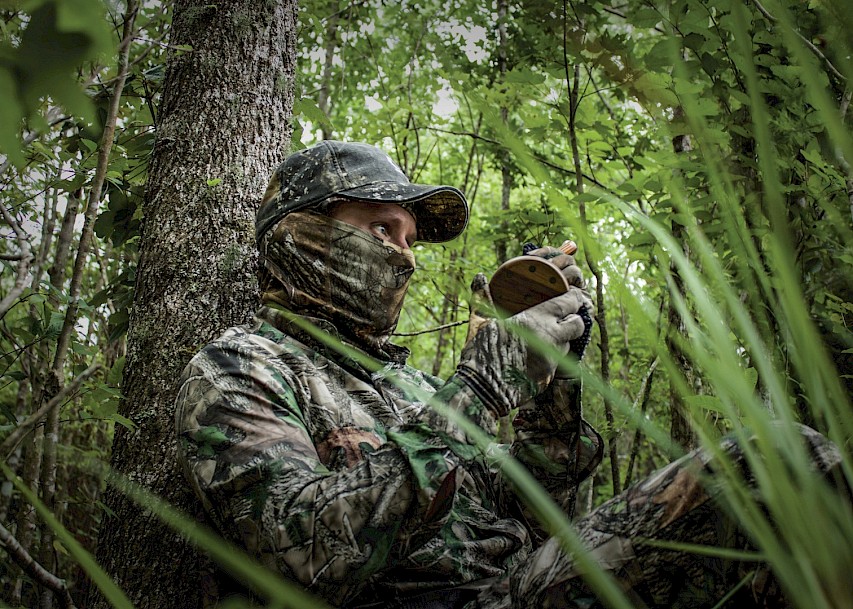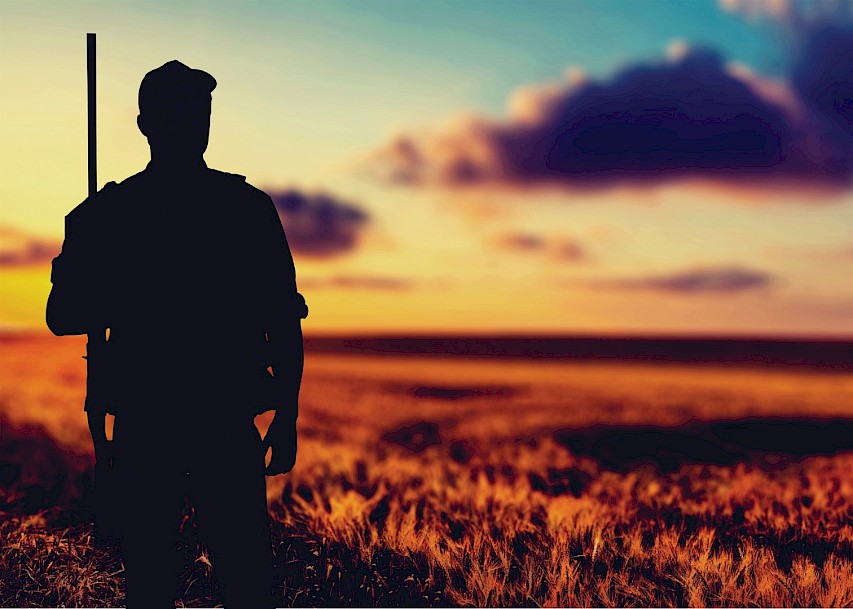Talking Turkey

Your Preseason Guide To Hunting Texas’ Wiliest Game Bird
Courtesy of Texas Parks & Wildlife Magazine
I scratch the wand across the slate call, and almost instantaneously, the tom turkey responds with a thundering gobble. For 30 minutes, we played a cat-and-mouse game of call and response. He gets closer each time.
Now, he’s 15 yards away. We are eye to eye.
In the shade, turkeys look dark and drab. In the sunlight, however, they shine with an iridescence not seen in many other Texas critters. Here in the early morning sunlight of the Texas Rolling Plains, this big ol’ tom is a kaleidoscope of ever-changing colors as the light hits from various angles.
When he steps from behind a mesquite tree, he’s in full strut. His feathers are puffed, and his bright red head is tucked into them. He fans his tail and drags his wings across the ground to make a noise that sounds like a long, resounding crunch.
He’s giving it his all to impress an unseen hen.
For fun, I scratch the call one last time to make him gobble. The noise and the scene are making my heart race.
Turkey hunting may be the most interactive type of hunting in Texas, as it happens in close quarters and at eye level.
From the first moment I saw a turkey up close, I was hooked. In hunting circles across Texas, turkeys may not always get top billing. Those who pursue the challenging bird will tell you there may not be a better hunt than a turkey hunt. The birds are wary and have excellent eyesight, helping them evade hunters. If turkeys had a good sense of smell, it would be nearly impossible to harvest one.

TURKEYS OF TEXAS
While the term “turkey” is generally used to describe the bird now found in 223 of Texas’ 254 counties, three subspecies of turkeys occur in the state. Regardless of the different subspecies, it wasn’t too long ago that turkeys in Texas were rare. Overhunted to near oblivion, turkey populations were at critical levels around the turn of the century. Turkey numbers have eventually increased thanks to trap-and-transport programs, and permanent populations have taken hold.
PRESEASON PREP
Unlike some types of hunting, there’s not a ton of preseason prep for turkey. However, like anything you plan to hunt, you owe it to the animal to do as much preparation as necessary for a safe and ethical hunt. Turkey hunting does require some specialized gear that’s not used in any other type of hunting. A thorough knowledge of your equipment and turkey hunting processes is essential.
FINDING A PLACE TO HUNT
In Texas, a hunting lease offers a tried-and-true method of securing a hunting location. Outfitters are another option. Some outfitters provide multiday hunts, with or without a guide. These hunt packages are less expensive—you don’t have to commit the financial resources to secure a yearlong lease.
Suppose you are looking for public land hunting. Texas Parks and Wildlife Department offers more than 1 million acres of land for public hunting. With a $48 Annual Public Hunting permit, you can access all the lands in the portfolio for various hunting opportunities; a handful of them offer turkey hunting.
If you’re an avid hunter who needs more than one turkey hunt, a yearlong lease does allow you to pursue other types of game when they are in season. You can talk to a local Texas AgriLife extension agent, Texas Parks and Wildlife biologist, game warden, or local chambers of commerce. Often, these folks can help connect you with landowners looking to lease their property.

CAMO AND OTHER GEAR
Turkeys have incredibly keen eyesight and are adept at pinpointing movement. Therefore, wearing camouflage is essential for pursuing these wary creatures. For the utmost stealth, match your camouflage to your hunting habitat and cover yourself from head to toe, including gloves and a head net.
To hunt travel corridors, you only need camouflage and a means to harvest the bird. If you want a completely interactive experience, you’ll also need a turkey call. Of the three types of turkey calls—box, slate, or diaphragm—box and slate calls are the easiest to learn and master. The key to being a good turkey caller is to practice.
Rounding out the complete turkey hunter’s gear list is a turkey vest. These vests hold your calls and shotgun shells and have an integrated pad for you to sit on in the field. Hang a good set of binoculars around your neck, too.
Some hunters like to use turkey decoys to get an amorous tom’s attention and lure him closer.
LICENSE, PERMITS, AND REGULATIONS
Texas requires a hunting license for anyone who hunts. The price varies depending on age, license types, and other factors. Licenses are readily available in person at sporting goods retailers or Texas Parks and Wildlife Department field offices, and online through the TPWD website.
Hunter Education is a good idea for anyone who hunts. It teaches valuable information and skills to make every outdoor excursion a safe and responsible one and is required if you were born on or after Sept. 2, 1971.
Hunter safety training comes in many forms but essentially consists of six hours of classroom or online training, plus field training for hunters under 17 years old. An online-only version is also available for hunters 17 and over.
In the preseason, before you go afield, take the time to understand all the game laws and limits for each area and the turkey subspecies you hunt.
STAYING SAFE
With any kind of hunting, safety is paramount.
When turkey hunting, always be sure of your target and what lies beyond your target. Turkeys move through thick brush and are stealthy. What you think is a turkey splitting through the brush may be a cow, dog, or person. Never fire on an obscured target.
Wearing blaze orange isn’t required while hunting on private land, but it is a good idea to wear it while traveling to and from your hunting area. You don’t want to be seen by turkeys, but you do want to be seen by other hunters when you move.
One important word of advice: Never wear red, white, blue, or black on a turkey hunt. Those colors can be mistaken for a turkey’s head or body.
Running through various safety scenarios in the field is always helpful. Understanding where you are likely to shoot and what lies beyond your target are the building blocks of a safe hunt.
The bottom line? Make sure of your target all the time.
Enjoy the turkeys—don’t be one.




